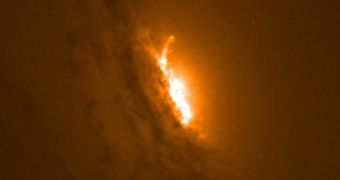As it turns out, supermassive black holes are masters of the Heimlich maneuver. Otherwise put, they have the ability to make galaxies cough out massive amounts of molecular gas and, in doing do, very much shape the universe as we know it.
In a recent paper in the journal Nature, scientists explain that, as shown by previous investigations, supermassive black holes like to pass the time blowing molecular gas out of the galaxies at whose core they are located.
The outflows birthed by such black holes are so massive that, in time, their host galaxy is left without much of the gas it needs in order to form new stars. Consequently, its appearance and evolution are altered.
Hoping to gain a better understanding of such phenomena, researchers with the University of Sheffield in the United Kingdom have turned to data provided by the Very Large Telescope of the European Southern Observatory in Chile.
As detailed in a press release on the matter at hand, the scientists have looked at what a nearby galaxy dubbed IC5063 has been up to lately, and focused on what the very active supermassive black hole at its center has been doing to keep itself entertained.
It has thus been discovered that the black hole at the core of IC5063 blows molecular hydrogen gas out of its host galaxy at an impressive speed of about 1 million kilometers per hour (approximately 0.62 million miles per hour).
Writing in the journal Nature, the scientists who have worked on this research project detail that these massive and stunningly outflows of molecular gas are birthed by energetic jets of electrons propelled by the supermassive black hole.
Thus, it is in regions where these jets of electrons collide with dense gas that the massive outflows altering the galaxy's appearance and impairing its ability to birth new stars occur, the University of Sheffield researcher further explain.
“Much of the gas in the outflows is in the form of molecular hydrogen, which is fragile in the sense that it is destroyed at relatively low energies. It is extraordinary that the molecular gas can survive being accelerated by jets of electrons moving at close to the speed of light,” Professor Clive Tadhunter says.
The outcome of this investigation is expected to help make better predictions concerning the future of our own galaxy, the Milky Way, which is to collide with a neighboring galaxy dubbed Andromeda in about 5 billion years.
Scientists say that, when this happens, gas will built up at its center of the system. In time, the black hole at the galaxy's core will push it out, and our Milky Way will embark on an evolutionary path similar to that documented in the case of IC5063.

 14 DAY TRIAL //
14 DAY TRIAL //